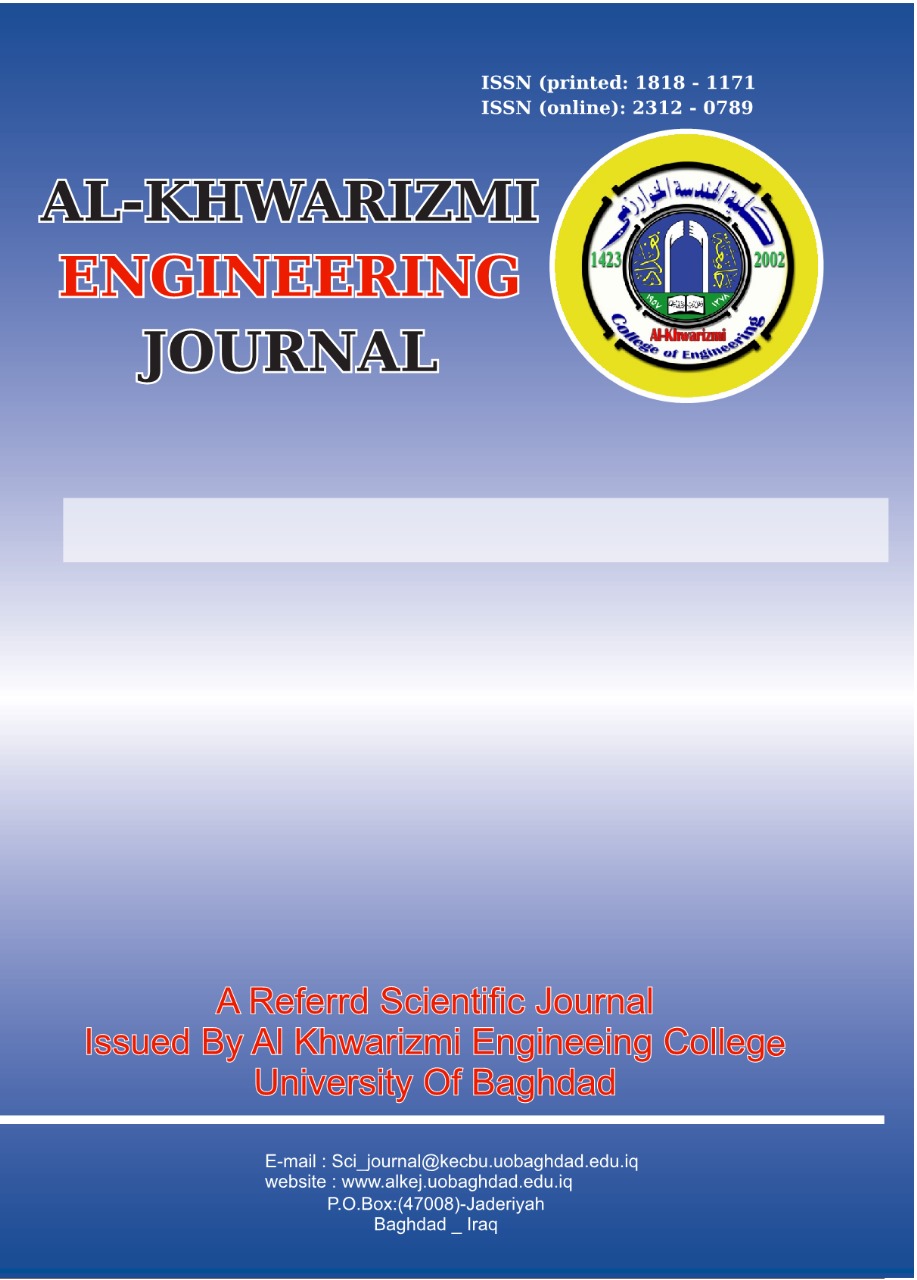Monitoring Alkalinity and Hardness During Treatment of Different Water Types
DOI:
https://doi.org/10.22153/kej.2024.08.004Abstract
Alkalinity and hardness are crucial factors in water treatment procedures, such as electrocoagulation (EC) and traditional coagulation–flocculation. Two types of water were employed in this study to investigate the use of EC: river water and discarded reverse osmosis system water. With bipolar and monopolar aluminum electrodes, continuous flow tests were conducted to evaluate the effects of different parameters on the variations in alkalinity and hardness versus time. The examined factors were flow rate (600 and 1,000 L/h) and number of electrodes (2 and 4). Polarity reversal was also studied. The water passed through the plates in a zigzag pattern. Results showed that the hardness under all operating conditions decreased with time, and alkalinity exhibited an oscillating behaviour. The ideal hardness removal for treating river and concentrated water was obtained using four plates with polarity reversal and a flow rate of 1,000 L/h, which were equal to 37.5% and 33.3%, respectively.
Downloads
References
S. Elia, M. Stylianou, and A. Agapiou, “Aroma characterization of raw and electrochemically treated goat whey wastewater,” Sustain Chem Pharm, vol. 27, Jun. 2022, doi: 10.1016/j.scp.2022.100640.
V. M. García-Orozco, G. Roa-Morales, I. Linares-Hernández, I. J. Serrano-Jimenes, M. A. Salgado-Catarino, and R. Natividad, “Electrocoagulation of a chocolate industry wastewater in a Downflow column electrochemical reactor,” Journal of Water Process Engineering, vol. 42, Aug. 2021, doi: 10.1016/j.jwpe.2021.102057.
T. Shahriari, A. R. Karbassi, and M. Reyhani, “Treatment of oil refinery wastewater by electrocoagulation–flocculation (Case Study: Shazand Oil Refinery of Arak),” International Journal of Environmental Science and Technology, vol. 16, no. 8, pp. 4159–4166, Aug. 2019, doi: 10.1007/s13762-018-1810-z.
R. Niazmand, M. Jahani, and S. Kalantarian, “Treatment of olive processing wastewater by electrocoagulation: An effectiveness and economic assessment,” J Environ Manage, vol. 248, Oct. 2019, doi: 10.1016/j.jenvman.2019.109262.
Gunarif Taib, Wenny Surya Murtius, Risa Meutia Fiana, and Wahyunanto Agung Nugroho, “Systematic literature electrocoagulation for wastewater treatment: Mini-review,” World Journal of Advanced Research and Reviews, vol. 18, no. 2, pp. 690–699, May 2023, doi: 10.30574/wjarr.2023.18.2.0812.
L. T. N. Maleiva, P. W. Nugraheni, F. Ramadhan, L. S. A. Putra, and E. Kusumawardhani, “Treatment of Dug Well Water in Kubu Raya, West Kalimantan, with Electrocoagulation,” IOP Conf Ser Earth Environ Sci, vol. 1228, no. 1, p. 012013, Aug. 2023, doi: 10.1088/1755-1315/1228/1/012013.
R. Danial, L. Chuah Abdullah, and S. Sobri, “Potential of Copper Electrodes in Electrocoagulation Process for Glyphosate Herbicide Removal.”
J. N. Hakizimana, N. Najid, B. Gourich, C. Vial, Y. Stiriba, and J. Naja, “Hybrid electrocoagulation/electroflotation/electrodisinfection process as a pretreatment for seawater desalination,” Chem Eng Sci, vol. 170, pp. 530–541, Oct. 2017, doi: 10.1016/j.ces.2017.04.029.
A. Dubey and A. Tewari, “Performance of Aluminium Electrode in Defluoridation of Water During Electrocoagulation,” Materials Focus, vol. 7, no. 5, pp. 657–661, Oct. 2018, doi: 10.1166/mat.2018.1560.
G. B. Raju, M. T. Karuppiah, S. S. Latha, S. Parvathy, and S. Prabhakar, “Treatment of wastewater from synthetic textile industry by electrocoagulation-electrooxidation,” Chemical Engineering Journal, vol. 144, no. 1, pp. 51–58, Oct. 2008, doi: 10.1016/j.cej.2008.01.008.
A. Saiba, S. Kourdali, B. Ghernaout, and D. Ghernaout, “In desalination, from 1987 to 2009, the birth of a new seawater pretreatment process: Electrocoagulation-an overview,” Desalination and Water Treatment, vol. 16, no. 1–3. Taylor and Francis Inc., pp. 201–217, 2010. doi: 10.5004/dwt.2010.1094.
D. Franco, J. Lee, S. Arbelaez, N. Cohen, and J. Y. Kim, “Removal of phosphate from surface and wastewater via electrocoagulation,” Ecol Eng, vol. 108, pp. 589–596, Nov. 2017, doi: 10.1016/j.ecoleng.2017.07.031.
D. R. Ryan, P. J. McNamara, and B. K. Mayer, “Iron-electrocoagulation as a disinfection byproduct control strategy for drinking water treatment,” Environ Sci (Camb), vol. 6, no. 4, pp. 1116–1124, Apr. 2020, doi: 10.1039/d0ew00106f.
C. Ucar, M. B. Baskan, and A. Pala, “Arsenic removal from drinking water by electrocoagulation using iron electrodes,” Korean Journal of Chemical Engineering, vol. 30, no. 10, pp. 1889–1895, Jun. 2013, doi: 10.1007/s11814-013-0128-2.
B. Zhu, D. A. Clifford, and S. Chellam, “Comparison of electrocoagulation and chemical coagulation pretreatment for enhanced virus removal using microfiltration membranes,” Water Res, vol. 39, no. 13, pp. 3098–3108, 2005, doi: 10.1016/j.watres.2005.05.020.
Downloads
Published
Issue
Section
License
Copyright (c) 2024 Al-Khwarizmi Engineering Journal

This work is licensed under a Creative Commons Attribution 4.0 International License.
Copyright: Open Access authors retain the copyrights of their papers, and all open access articles are distributed under the terms of the Creative Commons Attribution License, which permits unrestricted use, distribution, and reproduction in any medium, provided that the original work is properly cited. The use of general descriptive names, trade names, trademarks, and so forth in this publication, even if not specifically identified, does not imply that these names are not protected by the relevant laws and regulations. While the advice and information in this journal are believed to be true and accurate on the date of its going to press, neither the authors, the editors, nor the publisher can accept any legal responsibility for any errors or omissions that may be made. The publisher makes no warranty, express or implied, with respect to the material contained herein.
















